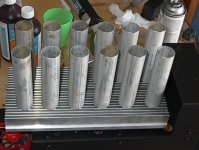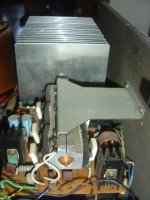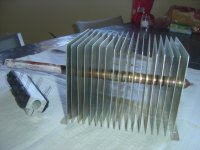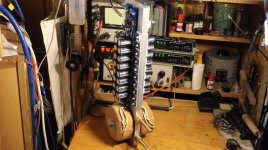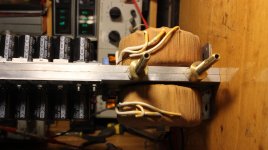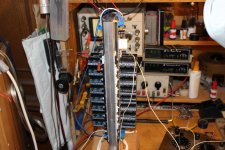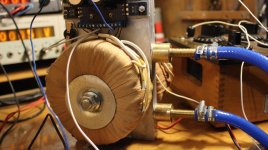I used the chimney cooling on a high power amp here
It is very effective. I have driven this amp very hard and the cooling that I get from this arrangement has been enough.
Granted, this is not class A but there is still a lot of dissipation at high output.
It is very effective. I have driven this amp very hard and the cooling that I get from this arrangement has been enough.
Granted, this is not class A but there is still a lot of dissipation at high output.
Attachments
Ah yes, the flat-12 look. And to think that Ferrari went with the V-12 option. How silly of them.
I'm tempted to put together a water cooled GR-25. That critter puts out some heat, but is small enough that I can put it on a reduced capability system without having to worry about overloading it. A cooling tower and and convection water flow might be just the ticket.
Grey
I'm tempted to put together a water cooled GR-25. That critter puts out some heat, but is small enough that I can put it on a reduced capability system without having to worry about overloading it. A cooling tower and and convection water flow might be just the ticket.
Grey
As a watercooling fan,
I have some input for this thread.
Copper is your friend. Silver is your BEST friend.
The best way to get heat away from small point sources, be it either a CPU or a point device like a mosfet/transistor is to treat the system as a simple resistive circuit, like electronics.
The aim is the smallest overall resistance from device to air, and thats what it all comes down to. Any kind of barrier, interface, junction all adds resistance to your circuit, and reduces the ability for heat to flow.
Ok, The point of highest heat density is the device itself. You are looking at a semiconductor junction at best a few square mm in size dissipating a LOT of thermal energy in a small size. You need to allow that heat to get out of the device.
Mount your device on a totally flat surface. In the computer side of things, we do whats called "lapping" where we take our interfaces (water block and cpu) and lap them down with progressively finer grades of wet and dry sandpaper, on a extremely flat surface.
My particular favourite surface is the discard platten out of old photocopiers.
They are optically flat, perfect for this job.
so, 1: Maximise your thermal contact. Us computer nerds often use silver compounds between our lapped devices to minimise thermal resistance.
so. You have now got your heat away from the device, either using a flat silver or copper plate. Silver is more conductive, but obviously more expensive.
Ideally, you want your flow of coolant to run over this plate in a turbulent flow to maximise contact between the heated metal and the coolant. There are a thousand and one ways to do this, but its a science in the computer industry because low temp is the goal for overclocking.
In the amplifier scenario, the absolutely lowest temp is not a requirement, a more constant and stable temp is desired.
So far, you have a flat device, attached firmly to a flat metal block, with liquid flowing through it. You need a pump, and a radiator to put this heat into the air, or something else.(fishtank)
The beauty of watercooling is that you can pipe fluid from anywhere else. You can have your class A amp making a tonne of heat, and being able to take that heat and dissipate it outside or in another room.
Depending on the amount of flow required, you can use aquarium pumps, ehiem as mentioned in this thread, or any other kind of pump really, as mounting it away from the amp is very easy.
And last but definitely NOT least is your radiator.
You can use oil coolers, heater cores, car radiators, any kind of device that allows you to use a fan to push air through. There are advantages and disadvantages to each kind, if you are restricted in size, you can get radiators specifically designed for computer applications, taking computer fans.
If you are watercooling though, quietness is more then likely your goal.
Watercooling is technically a misnomer.
Its still air cooling. You are just MOVING the heat to another location, or to a bigger surface area to allow more efficient air cooling.
As for the fluid, as you can see in my picture, i just premixed radiator car coolant.
Looks cool, and it also includes a pump lubricant that makes your pump last longer, and run quieter, and it also helps keep your blocks and radiator clean.
Sorry for the huge pic but you can see the detail of how i cooled various devices in my computer.
I make all my own copper coolers using plumbing parts.
An externally hosted image should be here but it was not working when we last tested it.
I have some input for this thread.
Copper is your friend. Silver is your BEST friend.
The best way to get heat away from small point sources, be it either a CPU or a point device like a mosfet/transistor is to treat the system as a simple resistive circuit, like electronics.
The aim is the smallest overall resistance from device to air, and thats what it all comes down to. Any kind of barrier, interface, junction all adds resistance to your circuit, and reduces the ability for heat to flow.
Ok, The point of highest heat density is the device itself. You are looking at a semiconductor junction at best a few square mm in size dissipating a LOT of thermal energy in a small size. You need to allow that heat to get out of the device.
Mount your device on a totally flat surface. In the computer side of things, we do whats called "lapping" where we take our interfaces (water block and cpu) and lap them down with progressively finer grades of wet and dry sandpaper, on a extremely flat surface.
My particular favourite surface is the discard platten out of old photocopiers.
They are optically flat, perfect for this job.
so, 1: Maximise your thermal contact. Us computer nerds often use silver compounds between our lapped devices to minimise thermal resistance.
so. You have now got your heat away from the device, either using a flat silver or copper plate. Silver is more conductive, but obviously more expensive.
Ideally, you want your flow of coolant to run over this plate in a turbulent flow to maximise contact between the heated metal and the coolant. There are a thousand and one ways to do this, but its a science in the computer industry because low temp is the goal for overclocking.
In the amplifier scenario, the absolutely lowest temp is not a requirement, a more constant and stable temp is desired.
So far, you have a flat device, attached firmly to a flat metal block, with liquid flowing through it. You need a pump, and a radiator to put this heat into the air, or something else.(fishtank)
The beauty of watercooling is that you can pipe fluid from anywhere else. You can have your class A amp making a tonne of heat, and being able to take that heat and dissipate it outside or in another room.
Depending on the amount of flow required, you can use aquarium pumps, ehiem as mentioned in this thread, or any other kind of pump really, as mounting it away from the amp is very easy.
And last but definitely NOT least is your radiator.
You can use oil coolers, heater cores, car radiators, any kind of device that allows you to use a fan to push air through. There are advantages and disadvantages to each kind, if you are restricted in size, you can get radiators specifically designed for computer applications, taking computer fans.
If you are watercooling though, quietness is more then likely your goal.
Watercooling is technically a misnomer.
Its still air cooling. You are just MOVING the heat to another location, or to a bigger surface area to allow more efficient air cooling.
As for the fluid, as you can see in my picture, i just premixed radiator car coolant.
Looks cool, and it also includes a pump lubricant that makes your pump last longer, and run quieter, and it also helps keep your blocks and radiator clean.
Sorry for the huge pic but you can see the detail of how i cooled various devices in my computer.
I make all my own copper coolers using plumbing parts.
I think this will solve the issue for a nice solid metal to metal connection. Per the pic, a channel is machined to encapsulate the pipe into the block creating a solid metal to metal connection. Yes it will take a lot of solder with the length of the piece at 12", but I think this will be optimal.
IMO
Luxman used this practice in their 1984 A504 Class A poweramps. They used, I believe, either freon or oil in the copper pipe. Each pipe with fins manages to keep 6 x 2sa1215/2sc2921s cool, whilst operating at 60W class A, each. At the 'warm up' stage you can hear the odd 'gurgle' from the pipes, but nothing of concern.
Something else which may be of interest and has been creating a lot of threads in the computer world is "submersion in Mineral Oil".
See here:- Mineral Oil Submerged Computer; Our Most Popular Custom PC
Attachments
Ive looked into the slightly more esoteric methods of cooling - planning on building either an F-5 or a quad of Zen - V4 (parallel channels) and the cost of big comercial extrusions is out.
And the physical size would impinge on my living space, so i looked into 'liquid' cooling.
Now, luckily for me i have a landlord who dont mind me makeing holes in walls n such and i have an agreement with my neighbours that i only play LOUD from 10 am - 8PM, when the kid upstairs goes nini!
I miss-spent my youth tuneing raceing two-stroke engines for bikes and oh how we love our liquid cooling..........though its helped in that instance by plenty of forced air.
So, i had the thought that i could build big hot amps, liquid cool em but use a normal double pannel central heating radiator in my excruciatingly cold bedroom so it was of interest when this thread showed on the home page.
I had two problems with liquid cooling - one was the heat block, ive frinds with machine-shops, so i looked into milling a 2 pice block with chanels, gaskets and other stuff BUT never concidered a hole up though a block of metal, ONLY two joints to seal. Same with the pipe n plate method and though cheaper to implement I dont like the soldering part (even silver solder(some people call this 'hard' solder)).
Though just haveing a brainwave - bore hole off-center in block of metal, then turn fittings on the ends! I'd use aluminium, reason being it'd be cheaper in tooling.
the other problem - i might be moveing soon and all this paper desighn looks to be a pain in the airosol.
all this thinking just so i can have a go at horn speakers
And the physical size would impinge on my living space, so i looked into 'liquid' cooling.
Now, luckily for me i have a landlord who dont mind me makeing holes in walls n such and i have an agreement with my neighbours that i only play LOUD from 10 am - 8PM, when the kid upstairs goes nini!
I miss-spent my youth tuneing raceing two-stroke engines for bikes and oh how we love our liquid cooling..........though its helped in that instance by plenty of forced air.
So, i had the thought that i could build big hot amps, liquid cool em but use a normal double pannel central heating radiator in my excruciatingly cold bedroom so it was of interest when this thread showed on the home page.
I had two problems with liquid cooling - one was the heat block, ive frinds with machine-shops, so i looked into milling a 2 pice block with chanels, gaskets and other stuff BUT never concidered a hole up though a block of metal, ONLY two joints to seal. Same with the pipe n plate method and though cheaper to implement I dont like the soldering part (even silver solder(some people call this 'hard' solder)).
Though just haveing a brainwave - bore hole off-center in block of metal, then turn fittings on the ends! I'd use aluminium, reason being it'd be cheaper in tooling.
the other problem - i might be moveing soon and all this paper desighn looks to be a pain in the airosol.
all this thinking just so i can have a go at horn speakers
Many years go I built a 30 watt per channel class a amplifier that used cut open TO3 devices .i.e. the lids were cut off exposing the silicon dies .These were imersed in a tank of
light transformer oil about a gallon Now that was effective as far as cooling went !!!
The only reason I dropped it was that after a days running you could smell hot oil but while experimenting you could see the oil convecting away from the output device chips
regards Trev
light transformer oil about a gallon Now that was effective as far as cooling went !!!
The only reason I dropped it was that after a days running you could smell hot oil but while experimenting you could see the oil convecting away from the output device chips
regards Trev
Many years go I built a 30 watt per channel class a amplifier that used cut open TO3 devices .i.e. the lids were cut off exposing the silicon dies .These were imersed in a tank of
light transformer oil about a gallon Now that was effective as far as cooling went !!!
The only reason I dropped it was that after a days running you could smell hot oil but while experimenting you could see the oil convecting away from the output device chips
regards Trev
That reminds me of the old ham radio trick of putting a resistor in an oil tank for testing at really high power, like far higher than the thing was rated for... I did that actually. Had a Mason jar filled with mineral oil and an 8 ohm, 20 watt resistor in it with a lid and leads and the whole works. I'm sorry it's gone now.
State-change is considerably different from just pumping liquid around. You can also consider hybrids like colid-state peltier cooler piles at the device, then liquid cooling of the hot side of the peltier piles.
So.... let's see. A 90watt Peltier takes about 6 amps at 12VDC. So, assuming a stereo amp, we need two of these buggers, plus a power supply... 150 watts for the Peltier devices alone. You want frost on those outputs?!??!?
My new system. Repeater 120 watt Class A - three bands perfect solution AKVABLOK ??????????? ???????????? ??????????? - YouTube and even roller ??????????? ???????????? ???????????. ?????2 - YouTube
Monoblocks are water-cooled completely silent in operation and moreover are compact enough. Quiescent current repeater 3. 5 A for the N - P - N channel and P - N - P channel in the amount of 7A. Power supply + - 36Volt.Vyhodnaya 100 watts
Attachments
http://www.diyaudio.com/forums/soli...nnel-p-n-p-channel-repeater-plated-input.html Post 174 compact monoblock szes scheme
Disc title Lullaby by HillsNice amp, and what a great system you have Fedosoff.
What is the name of the music in the second video from 16:26 to 17:42 ?
- Status
- This old topic is closed. If you want to reopen this topic, contact a moderator using the "Report Post" button.
- Home
- Amplifiers
- Solid State
- Water cooled audio circuitry
